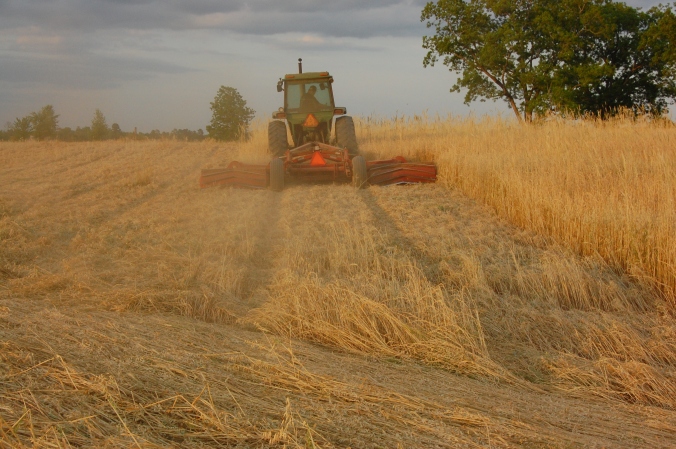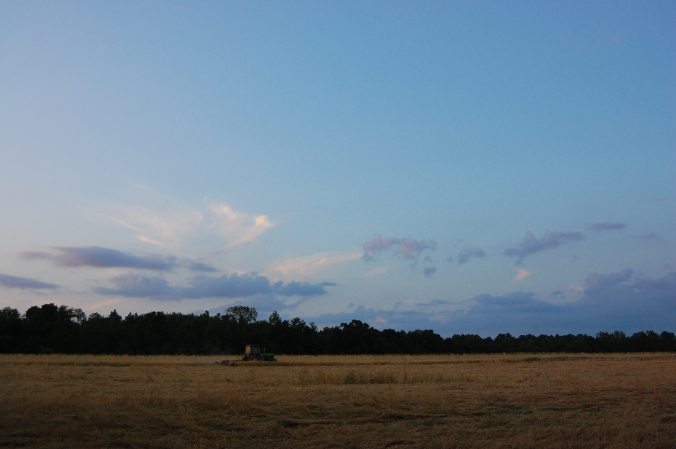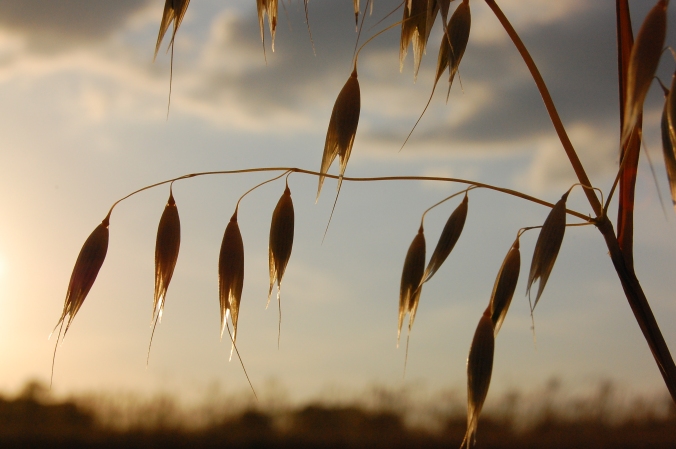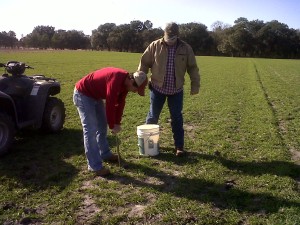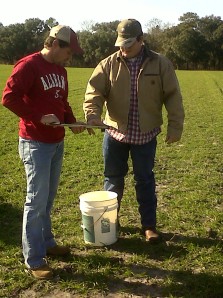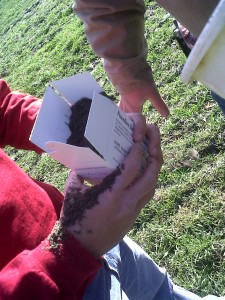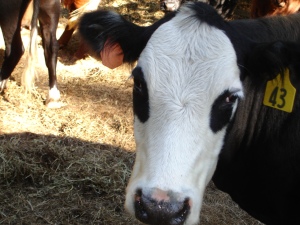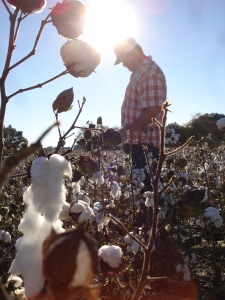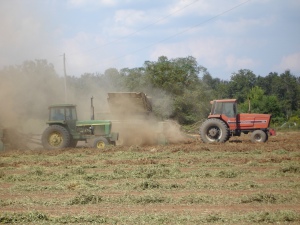Author: Jared
That Ain’t The Way It’s Done
Howdy Folks!
I have been involved with agriculture all my life and have seen beauty in things that I am almost positive nobody but a farmer could appreciate. I have also seen some “not so beautiful” things through the years, all in harmony with the daily tasks involved on a row crop and cattle farm. This morning Jillian called and informed me of a video showing dairy calves being rendered unconscious with a blow to the head by a claw hammer and a pick-axe (sharp shooter). I would just like to say that of all the bad things that I have witnessed on a farm, this had to be at the top of my list for the most careless, unethical, and stupid way of euthanizing animals that I have ever seen. Myself, as well as every other farmer, rancher, and dairyman that I know, bend over backwards to ensure that our livestock are taken care of to the fullest extent. I can’t tell you how many mornings that, I personally, have gotten up well before 4:00 to care for our bottle calves and to make sure that they are warm, healthy, and happy. Or how many late nights we have stayed up pulling calves and nursing sick animals back to health. I can only imagine how much work others have done on their larger operations to ensure good care is given to all of their animals.
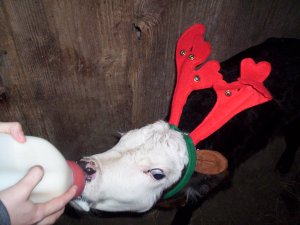
This is Babe. She is a heifer that Jillian, her family and I bottle raised several Christmases ago. While we haven't had anymore calves to bottle feed since then, we still keep a check on the babies and their mamas to make sure they are getting enough to eat and are healthy.
When I see this video, I feel as though many people who are not familiar with the livestock industry might come to the conclusion that this is the way all animals are treated. Not by a long shot. It only takes one bad apple to ruin the batch, and I hope these bad apples are prosecuted to the fullest. When I see this, it makes me feel as though all of the hard work that we as farmers, ranchers, and dairymen put into our operations to improve the quality of life for our animals and to educate people on the real way animals are treated on all modern farms goes to the wayside. How do these people justify these cruel and unethical acts? How can the organization that released this material (Mercy for Animals) say that going vegan will change these careless practices?
The answer is not to eliminate animal products from our lives; it is to educate the public on how animals are treated on the majority of all modern operations who take extra care of their animals because the animals take care of them. We are placed on this earth to be good stewards of the land and animals that are provided for us. Those very few who use unethical practices will not be in business very long in today’s agriculture code of ethics.
On another note, tune in later to hear about conservation tillage and new practices being used on cover crops to help suppress Palmer amaranth (Roundup resistant pigweed) and ways to conserve moisture before planting.
Until next time keep your nose clean and don’t take any wooden nickels.
—Jared
Ag and Twitter? Hmmm…
Howdy Folks!
It’s been a while since I have posted and I would like to apologize for that. As our busy winter is winding down and an even busier spring is almost upon us, I would like to take a minute to talk about an interesting trip that I made between my last blog post and now. On January 8, Jillian and I went to Atlanta for an Ag Chat Foundation meeting. I’ll have to admit that I have never been one for Twitter… you know getting tweets ALL the time, every one asking questions or posting what is on their mind continuously, and getting all those “@#to” symbols followed by something that I had to look twice at to understand what it was. Heck, I aint been long just learned how to use email and Facebook so why in the word would I give a hoot about twitter? That is exactly what I was asking myself on our drive to the hub of the south.
Once we got to the meeting, I met some people whom I had heard of through Jillian’s Twitter account. These people were from all across the U.S. and were very interesting. I learned at that meeting, that there are people all across this country that are very passionate about agriculture and work hard to meet the demands of our ever growing population. People, who like me, love their work and enjoy telling others about where their food comes from and how it got there. At the conference we met dairy farmers from Wisconsin and California, a farm mom from North Dakota and people from industry leaders like AGCO. Not to mention a red headed woman from Memphis who talked about cotton ALL the time…
As I sat through this meeting I began to realize that all of those “@#to” mumbo jumbo symbols were people that were communicating about agriculture, the very same way we strive to do with this blog. People that behind all of those modern CB handle Twitter names were very educated folks making the most of their resources to bring food to the American consumer and preserve a way of life.
So while I still do not have a Twitter account, I do have a new found respect for those in agriculture who use twitter as a means of communication. Who knows one day I might just get all technical and get me one of them there phones that has a Twitter thing on it…
Until next time… keep the greasy side down!
Jared
The Importance of Soil Sampling
Howdy folks,
I know that I have mentioned it a time or two but I would like to visit the topic of soil sampling.
When most folks look at soil they say “Oh yeah, that’s dirt, its everywhere, no big deal.” What most people do not think about is that the ground beneath their feet is what agriculture is founded upon.
The definition given for soils from Soil Taxonomy, second edition is—“Soil – soil is a natural body comprised of solids (minerals and organic matter), liquid, and gases that occurs on the land surface, occupies space, and is characterized by one or both of the following: horizons, or layers, that are distinguishable from the initial material as a result of additions, losses, transfers, and transformations of energy and matter or the ability to support rooted plants in a natural environment.”
Shwoo, that’s a mouthful!
Basically in VERY over-simplified terms from an agronomic standpoint, soil supports plants and thus allows farmers to grow crops which provide the food that we need to survive and prosper.
Sometimes the soil needs amendments (additional nutrients or other materials that change the pH of the soil such as lime and sulfur) to meet the specific needs of the crops that are being grown.
Great…so how do we know which amendments to add?
Well I’m glad you asked!
The first step is to determine what crop will be grown on a particular location. If the crop is a perennial grass, such as Bahiagrass or Bermudagrass for pastures or hay patches, samples should be taken at a depth of 2-3 inches. Grasses have a shallow fibrous root system and samples taken below the root system would be useless. If you are growing annual field crops such as cotton, soybeans, or peanuts the samples should be taken at a depth of 6-8 inches since these crops have a deep tap root system.
Ok, I know what crop I am going to grow and which field I am going to put it in, but how do I know where to collect the samples from?
Samples should be taken in a randomized zigzag pattern starting at one corner of the field and preceding to the other end of the field collecting the samples at the appropriate depths. Once the samples have been collected using a soil probe, the soil should be well mixed in a bucket and poured into an appropriate soil box to be sent off for testing (contact your local Cooperative Extension System Office for soil boxes and sample information sheets. The boxes will have directions to where the samples need to be mailed). Each soil box should represent 10 acres unless different soil types are encountered within those 10 acres. If this should happen, take samples of both soil types and place them in separate boxes.
Each crop has an optimum pH range. Recommendations will be made on your soil report instructing you what to do if your soils are out of range for the crops to be grown. Generally if the pH is too low for your crop limestone may be required to raise the pH. If the pH is too high, sulfur may be added to lower the pH. Usually, the soils in the southeastern part of the U.S. tend to be sandy and slightly acidic (unless you are in the Black Belt region).
Your report will also tell you what soil group you have, as well as the CEC (cation exchange capacity) for that group. It will also give recommendations of how much nitrogen (N), Phosphate (P2O5), and Potash (K2O) to apply. Remember folks, water is the most important factor in crop growth and development. Without water, nothing else really matters. Behind water is having the correct soil pH. And lastly, but of no lesser importance, are nutrients for proper growth and development; pH is ranked above nutrients because the pH has to be correct for proper uptake of those nutrients by the plant.
With production cost as high as they are in today’s market, it just makes sense to take good soil samples. Sometimes success just has to happen from the ground up!
Please feel free to leave comments or ask questions, I’d love to discuss it with you.
Until next time, y’all keep your eye on the road and the greasy side down!
Winter Work: If the cows ain’t happy…
Howdy Folks! It’s mighty cold this week in Dixie!
Although the crops are gathered and the cover crops have been planted, there are still plenty of things to be done on the farm. The first and foremost of these tasks is feeding the cattle through the winter. With no grass actively growing during the winter months, the cow’s entire daily intake has to be supplied by the farmer. Feeding a small herd though the winter months might not seem like much, but when the average cow weighs 1200 lbs and eats roughly 30-40 lbs of hay per day, for a small herd of 25 cows that totals up to almost 1000 lbs. of hay per day. So needless to say that keeping the cows fed is important.
Another important thing that we do on our farm this time of year is take soil samples. I cannot stress enough how important it is to take a good soil sample at least every other year and apply lime and fertilizer as necessary. Our sandy soils in south Alabama tend to be slightly acidic and periodically require lime to keep the soil pH within a range that is suitable for the crops grown in our region. It takes around 6 months for the pH to adjust, so we take samples and apply lime if necessary during the winter in order for the pH to be within range by the growing season.
(Psssst! Not sure what the Old Rotation is? Check this out: Oldest Continuous Cotton Rotation)
The winter months are fairly wet in our region which allows us to spend time in our shop to repair farm equipment. Equipment failures are inevitable on a farm and they always seem to happen when you need that piece of machinery the most. When pressed for time, such as during harvest, broke and busted equipment may get patched to minimize downtime. These patches will get you out of a tight, but generally need a little TLC over the winter months to be fixed properly so the breakdown doesn’t happen again. Winter is also a good time to prepare the tillage equipment for spring planting.

We had a serious breakdown this harvest on the peanut picker. The tongue almost pulled completely out of the body.
When we are not feeding cows, pulling soil samples, or fixing equipment, we are preparing our books for next year’s crop. Big decisions are made during the winter such as what to plant in the spring and which field to plant it on, how the commodity will be marketed, and which seed variety (brand or type of seed) to plant are among a few of the important decisions that will have to be made. A good way to get insight on these decisions is to attend meetings such as the Beltwide Cotton Conference, the Alabama/Florida Peanut trade show, or AG CONNECT to get market analysis reports, hear what has worked best for other farmers, and see what is new in the pipeline for the following year.
I have heard people say that farmers only work 6-8 months out of the year. Farmers may not be in the field over the winter, but they are always working. What do you think? Please feel free to respond!
Howdy folks!
Howdy folks! My name is Jared Etress and I would like to tell you a little bit about Etress Farms.
I am a small farmer (in acres not body mass) in southeast Alabama trying to make a living working the land that God has provided for us. I am also a senior at Auburn University pursuing a bachelor’s degree in agronomy and soils. Farming has been my passion ever since my granddaddy strapped my car seat into the cab of his 3090 Massey Ferguson. I spent countless hours with him in the cab of that tractor watching every move he made and learning from his example.
I learned fast that farming was more than just driving a tractor from one end of the field to the other. Farming takes dedication and perseverance, taking the good with the bad, and countless gallons of sweat. With all of this in mind, I decided at an early age that farming was going to be the life for me.
With my mind made up as to what I was going to do the rest of my life, I worked to learn as much as humanly possible about the occupation that feeds and keeps America running. After high school and junior college, I decided that the best way to become a better farmer and steward of the land was to enroll into Auburn’s agronomy and soils program. I am truly privileged to be able to go to school and learn better farming practices during the week, then take what I have learned home and apply it to my farming operation on the weekends.
For the 2011 crop year I plan on farming 120 acres of cotton, 35 acres of peanuts, and expanding mine and Jillian’s small beef cattle herd. Compared to a lot of farms these numbers are small but keep in mind that I am a beginning farmer and although the “want to” to increase the size of my farm is there, the funds do not always allow for it. Through this blog I hope to inform people of what really happens on a farm and the true meaning behind the methods used. I feel it important to mention that all of my efforts would be futile without the support of my family and most importantly my fiancé who sticks with me and continues to love me through thick and thin.
